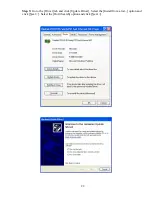
36
Fast Ethernet:
A 100 Mbps network communication system based on Ethernet and the CSMA/CD access
method.
Full Duplex:
Transmission method that allows two network devices to transmit and receive concurrently,
effectively doubling the bandwidth of that link.
Hub:
Central connection device for shared media in a star topology. It may add nothing to the transmission
(passive hub) or may contain electronics that regenerate signals to boost strength as well as monitor activity
(active/intelligent hub). Hubs may be added to bus topologies; for example, a hub can turn an Ethernet network
into a star topology to improve troubleshooting.
IEEE:
Institute of Electrical and Electronic Engineers.
IEEE 802.3:
Defines carrier sense multiple access with collision detection (CSMA/CD) access method and
physical layer specifications.
IEEE 802.3u:
Defines CSMA/CD access method and physical layer specifications for 100BASE-TX Fast
Ethernet.
IP Address
: IP stands for Internet Protocol. An IP address consists of a series of four numbers separated by
periods, which identifies a single, unique Internet computer host. Example: 192.34.45.8.
ISP
: Internet Service Provider. An ISP is a business that provides connectivity to the Internet for individuals
and other businesses or organizations.
Local Area Network (LAN):
A group of interconnected computer and support devices. It is made up of servers,
workstations, a network operating system and a communications link. Servers are high-speed machines that
hold programs and data shared by network users. The workstations (clients) are the users' personal computers,
which perform stand-alone processing and access the network servers as required.
LAN Segment:
Separate LAN or collision domain.
LED:
Light emitting diode is used for monitoring a device or network condition.
MAC Address:
MAC (Media Access Control) A MAC address is the hardware address of a device connected
to a network.
Media Access Control (MAC):
A portion of the networking protocol that governs access to the transmission
medium, facilitating the exchange of data between network nodes.
MDI / MDI-X:
Medium Dependent Interface - Also called an "uplink port," it is a port on a network hub or
switch used to connect to other hubs or switches without requiring a crossover cable. The MDI port does not
cross the transmit and receive lines, which is done by the regular ports (MDI-X ports) that connect to end
stations. The MDI port connects to the MDI-X port on the other device. There are typically one or two ports on
a device that can be toggled between MDI (not crossed) and MDI-X (crossed). Medium Dependent Interface –
X (crossed) - A port on a network hub or switch that crosses the transmit lines coming in to the receive lines
going out.



































